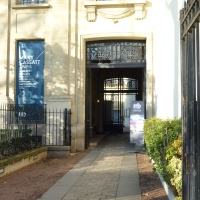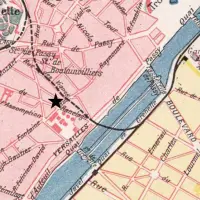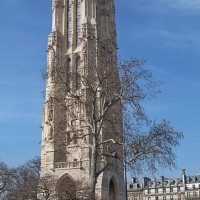It was the photograph that caught my eye from a high shelf in a bookshop. A street with a lamppost and the corner of a building; two men walking in opposite directions. It was only later that I registered the title: A Country Road, A Tree. Odd, I thought. That’s not countryside and there is no tree.*
I made a note of the title and got the book from the library. Jo Baker’s fictionalized account of Samuel Beckett’s war years in France is well-written and held my attention at a difficult time as I moved my mother to a long-term-care home. I recommend it unreservedly, but this is not a book review. It’s that cover photograph I want to talk about.
I should specify that I was reading the Canadian edition. The U.S. edition uses the same photograph, but not quite the same way. The U.K. edition and European editions use different photographs.
The acknowledgements credit the Roger Viollet / Image Works agency, but do not identify the photographer, only a colourist (meaning that the original image was black and white). There is no date. Searches of the Roger-Viollet and Paris en Images websites came up blank, and an email inquiry to the agency went unanswered.
After a certain amount of squinting at the blurry street sign at the top of the photograph, I decided it had to be rue Ramey, in the 18th. After a stroll down rue Ramey on Google Street View, I found the building. It’s at the very bottom (the south end of the street), at the corner of rue Ramey and rue de Clignancourt. The lamppost is long gone and the building has seen better days.
The building has two facades and two addresses – 2, rue Ramey and 51, rue de Clignancourt. Thanks to a marvellous website listing construction permits for the city of Paris from 1836 to 1939, I found that the original structure dates from at least 1877, the work of one Ferdinand Bal.
The photograph on the book shows the ground floor of the building modified, a bit crudely, to look like an Art Deco facade. Horizontal lines, cylindrical columns, stylish lettering, and an opening on to the corner, with letters spelling out the name of the enterprise, sitting on a curving ledge facing the intersection, only just visible end-on in the photo.
The photograph on the Canadian edition is cropped so that only the letters “UET” are visible on the left, but the U.S. edition shows more of the building and its surroundings, and we can see “UGUET.” Muguet? (Lily of the valley.) But it might be a last name, given to a business: Auguet, Buguet, Duguet, Fuguet, Huguet…?
Gallica to the rescue. Typing in the two addresses led to a small advertisement for les Magasins Au Muguet in the newspaper L’Intransigeant in 1935. It was a dress-shop and part of a chain with 35 branches. Several clothing shops had occupied that address: at the turn of the century it was called Pelissier, and in 1921 it was called Au Chic de Paris.
At the time the photograph was taken, the Art Deco modifications were getting tired and dirty and the front window was empty. This was a wartime photo, chosen because the book is set during the war. There are no vehicles visible: another clue.
The Canadian version, which has been cropped, has the effect of a bird’s-eye image or a modern photograph taken by a drone. The U.S. version, which is not so tightly cropped, shows that it was taken from the balcony of the building across the rue Ramey, which is fairly narrow. The pavement underneath the photographer is visible.
That is not all. Look at the lamppost with its crown on top. The base is squared off. Lampposts in Paris come in endless variations: six-sided versions, cylindrical versions, flared versions. Single lamps, double, quadruple.
The original is gone today, replaced by a tall modern version, but I found a similar base on a traffic light farther down the rue Ramey, at the intersection with rue de Custine.
But what is that cylindrical object halfway up the lamppost on the book cover? Some sort of signal to pedestrians or cars? There are clearly marked crossings (passages cloutés) in two directions. I consulted our friend Mireille, who suggested it might be a clock and directed me to this photograph.
In the end, the answer came from an organization called Mémoire de l’Electricité, du Gaz et de l’Eclairage (MEGE). I had read about this organization on a blog by someone called Sandrine, who had visited the tiny museum on the Journées du Patrimoine in September 2017. The organization is run by retired electricians and other workers who have maintained Paris’s street lighting over the years.
I sent an e-mail to MEGE on a Saturday evening and had my answer by Sunday morning:
L’objet que l’on peut observer sur le cliché que vous nous avez fait parvenir est un arrêt d’autobus (voir les photos jointes). Votre photographie a été prise pendant l’occupation car les vitres de la lanterne sont masqués par des plaques métalliques (défense anti-aérienne). La question que l’on peut se poser est ” pourquoi un arrêt de bus dans un virage entre deux passages cloutés ? “
The object visible on the image you sent is a bus stop (see the attached photos). The photograph was taken during the occupation because the glass on the lamp is masked by metallic plates (blackout requirements). The question one must ask oneself is “What is a bus stop doing on a curve between two pedestrian crossings?”
Good question, and I do not know the answer. Today, the No. 85 bus serves these streets, but because of a one-way system, the nearest stop is on the far side of the rue de Clignancourt.
The message from MEGE was accompanied by two photos of bus stops on lampposts, including this wonderfully moody one of a rainy day.
Sandrine’s blog provided another detail. This is a translation of what she wrote after her visit to the MEGE museum.
Savez-vous pourquoi les feux et lampadaires sont peints en marron à Paris ? …. Avant la seconde guerre mondiale, nos beaux lampadaires et feux de signalisation étaient en cuivre, laissé nu. Mais en 1940, quand la France a perdu la guerre, l’entreprise chargée de l’éclairage public de Paris a eu peur que les allemands ne piquent le cuivre. Ils ont donc lancé des travaux d’urgence pour peindre (avec la première peinture qui leur est tombée sous la main) tous les réverbères et feux de signalisation en cuivre avant l’arrivée des allemands. Nos éclairages peints en marron sont ensuite devenus typiques de la ville de Paris, et on les a gardés.
Do you know why traffic lights and lampposts are painted brown in Paris? Before the Second World War, our lamps and traffic lights were in copper, left unpainted. But in 1940, when France lost the war, the enterprise responsible for public lighting in Paris was afraid that the Germans would steal the copper. It launched an emergency project to paint (using the first paint that came to hand) all the copper lampposts and traffic signals before the Germans arrived. Our brown-painted lighting has since been typical of the city of Paris and has remained.
There is another, smaller piece of street furniture that also puzzled Mireille and me. The foreshortened perspective made us wonder at first if it was a fire hydrant. But we decided it was probably a boîte aux lettres. It struck me as unusual, since most letter boxes in Paris are set into walls. The base is also surprisingly massive for the small top, although that is probably protection against carriage wheels.
I found an earlier postcard with what appears to be the same object. The man standing nearby shows that these boxes were quite tall: one would have to reach up to insert mail. However, I could find nothing exactly like it in images from the Musée de la Poste, so perhaps it had another purpose.
What else is there? A manhole. The fan design of the cobblestones. And two men, walking in opposite directions. One wears a beret and a short jacket; the other a dark jacket, open-necked shirt, and no hat. The weather is likely coolish, but not cold. It’s a grey day, because there are no shadows.
I also found another view of the intersection, and immediately recognized the huge building looming in the background – the Dufayel department store. Aha, I thought, I have been here before.
I pondered why the photograph on the book cover had struck me so forcibly. And then I read the following by a man who was a teenager at the time of the Occupation, quoted in When Paris Went Dark by Ronald C. Rosbottom (2014):
The silence caught you by the throat, made sadness press into your thoughts. The houses had grown too tall, the streets too wide. People were separated from each other by spaces that were too big. Even the air which flowed down the empty streets was furtive and kept its secrets.**
The teenager who wrote this, Jacques Lusseyran, was blind. He was writing about how the streets felt to him. But the unknown photographer on the balcony across the street had caught an image of this emptiness, this space filled with secrets.
I found one other detail to add to my knowledge of this particular corner in Paris during the Second World War. On August 21, 1942, two former residents of the building at 51, rue de Clignancourt (the same building as 2, rue Ramey), had been sent from a transit camp in Beaune-la-Rolande to Auschwitz. They were part of a large convoy of children deported without their parents on that date. Joseph Epstein was 11 and his brother Marcel was 6.***
Text by Philippa Campsie; images from Google Street view and Mémoire des rues: Paris 18e arrondissement, Frédérique Bousquel, Parimagine, 2006
* The book is a fictionalized description of the experiences of Samuel Beckett during the war years; the title comes from the stage direction at the beginning of his play Waiting for Godot.
** Rosbottom, page xxxi to xxxii; the source is Jacques Lusseyran, Et la lumière fut [And there was light], 1953.
*** French Children of the Holocaust: A Memorial, Serge Klarsfeld, editor, NYU Press, 1996.






























Nice work my dear Watson. Cheers, Barney
What an absolutely fascinating post and first class sleuthing. I was particularly interested by the information that the public lighting workers painted the copper lamps brown to stop the Germans stealing them.
I intend to visit that museum on our next visit. I think there is a lot more to discover there!
I adore both your inquisitive mind and your tenacity, Philippa — you have taught me *so* much in this gem of a post! You’ve also illustrated beautifully the rabbit holes we lovers of Paris can tumble down when we go searching for a particular <> that speaks to us for reasons we sometimes can’t even articulate … only you tumble more deeply and with better research than anyone I know. Brava! Et merci infiniment aussi.
The rabbit holes never fail to draw us in. And Paris is full of them!
What an absolutely fascinating piece about an otherwise unremarkable corner in Paris. I loved following your detective work and was very impressed by the way the French have digitised these archives. Your links to start researching one’s own address were really helpful. Unfortunately I couldn’t find many references to 73 rue de Turenne in the IIIrd but although I knew it had been a boulangerie, I didn’t know it had also been an horlogerie.
When we moved in in 1997, the street was full of (mostly) men’s clothing wholesalers, with several bridal showrooms. Gentrification is now creeping upwards from the rue des Francs Bourgeois and the old character is changing. The shop on the ground floor of our building, which was one of the wholesalers, was bought by a man who received permission to transfer it back to an artisanal boulangerie. However, once he got the permit, his plans showed he wanted it to become another take-away, with tables outside for customers, which none of us who live in the building wanted to see happen. His builders arrived almost immediately and pounded away, even continuing after he had been told to stop work because of the damage to the fabric of the building. The work only stopped after a supporting wall in the basement had been demolished and our stairwell had to be reinforced. It looks terrifying now, with metal supports and red and white danger tape everywhere. It seems that there are lots of laws to stop people doing works on old buildings, we think ours dates from around 1800, but when someone actually starts it’s very difficult to stop them.
It looks now as though he has found a loophole (of course) and we are afraid our co-op may end up having to pay him damages AND restore the staircase.
But it won’t stop us loving our apartment and wanting to have a foothold in such a wonderful city, although our main home is in Sweden.
Very best regards
Jill (Rosenlund)
________________________________
What a lovely building! I had a look on Google Street View. I hope that things settle down and the character of the building will not be destroyed. Best wishes, Philippa
Your meticulous detective work makes for some delightful reconstructions of Paris. I love your detail…the bit about the copper lamp bases being painted to deceive the Nazis is a great bit of trivia to add to my cache of Paris lore.
Along the way, my friend Mireille sent me a link to a set of photographs of lampposts throughout France, organized by department. (http://phozagora.free.fr/?page=photofr) My goodness! What a labour of love! Lampposts galore.
I admire your tenacious ways. Thank you for sharing all your steps on solving the the story behind the picture.
I still hope one day to find out who the photographer was!
Your detailed information about Paris and your insights make your newsletter always so interesting. I am so impressed with the time and dedication you put into these newsletters so that we, your readers, can enjoy them thoroughly.
So glad to hear that you enjoy reading these blogs. Norman and I enjoy writing them!
I love your detective work!
Coming from you, that is high praise indeed!
Delicious detective work and rabbit hole worthy.
Barbara Felicetti
Ardmore PA
So glad you enjoyed it. Philippa
Not known as one being left speechless, you succeeded. Are you sure your name isn’t, just by chance, Hercule Poirrot? – This is magnificent and highly entertaining too.
I did some very little research on a very large framed photo I bought in the UK. (Aaah, my hidden love for France!). Without much thinking I always assumed that it ‘must be’ in Avignon until one morning, half awake, I thought: Well, this looks a bit like Montmartre, really….. Then I checked it with my photo material and indeed it was! I LOVE THIS KIND OF DETECTIVE STORY! THANK you so much….
Philippa & Norman; I have re-visited this post and realise that I haven’t read all of it when I commented. It was probably that I followed one of your links/indications or whatnot and replied without taking in the FULL content. It’s now even more spectacular, intruiging, and if possible, even more interesting. You are full of the most amazing ‘découvertes’ – I think Paris should make you Honorary Parisians, no less than that!
Dear Kiki, I love your enthusiasm and I am delighted that you enjoyed reading about this one little corner of the city. I did get a bit obsessed with it for a while! Best, Philippa
I can easily see that – I am also a bit like that but not for little corners of Paris, rather for even the most trifle things of my daily life, of certain aspects of history etc. Good woman!!!!